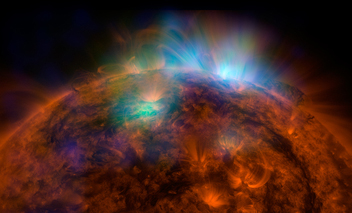
X-rays stream off the Sun in this image showing observations by NASA's Nuclear Spectroscopic Telescope Array, or NuSTAR, overlaid on a picture taken by NASA's Solar Dynamics Observatory (SDO). Image Credit: NASA/JPL-Caltech/GSFC
NEW YORK (PTI): A NASA space telescope designed to study black holes has taken its first picture of the Sun, producing the most sensitive solar portrait ever taken in high-energy X-rays.
"NuSTAR will give us a unique look at the Sun, from the deepest to the highest parts of its atmosphere," said David Smith, a solar physicist and member of the NuSTAR team at University of California, Santa Cruz.
Solar scientists first thought of using NASA's Nuclear Spectroscopic Telescope Array, or NuSTAR, to study the Sun about seven years ago, after the space telescope's design and construction was already underway (the telescope launched into space in 2012).
Smith had contacted the principal investigator, Fiona Harrison of the California Institute of Technology in Pasadena.
"At first I thought the whole idea was crazy. Why would we have the most sensitive high energy X-ray telescope ever built, designed to peer deep into the Universe, look at something in our own back yard?" said Harrison.
Smith eventually convinced Harrison, explaining that faint X-ray flashes predicted by theorists could only be seen by NuSTAR.
While the Sun is too bright for other telescopes such as NASA's Chandra X-ray Observatory, NuSTAR can safely look at it without the risk of damaging its detectors.
The first solar image from NuSTAR demonstrates that the telescope can in fact gather data about Sun.
It also gives insight into questions about the remarkably high temperatures that are found above sunspots - cool, dark patches on the Sun. Future images will provide even better data as the Sun winds down in its solar cycle, researchers said.
With NuSTAR's high-energy views, it has the potential to capture hypothesised nanoflares - smaller versions of the Sun's giant flares that erupt with charged particles and high-energy radiation.
Nanoflares, should they exist, may explain why the Sun's outer atmosphere, called the corona, is sizzling hot, a mystery called the "coronal heating problem."
If NuSTAR can catch nanoflares in action, it may help solve this decades-old puzzle.
"NuSTAR will be exquisitely sensitive to the faintest X-ray activity happening in the solar atmosphere, and that includes possible nanoflares," said Smith.
The X-ray observatory can search for hypothesised dark matter particles called axions. Dark matter is five times more abundant than regular matter in the Universe.
It's a long shot, say scientists, but NuSTAR may be able spot axions, one of the leading candidates for dark matter, should they exist. The axions would appear as a spot of X-rays in the centre of the Sun.
 Previous Article
Previous Article Next Article
Next Article













The Indian Air Force, in its flight trials evaluation report submitted before the Defence Ministry l..
view articleAn insight into the Medium Multi-Role Combat Aircraft competition...
view articleSky enthusiasts can now spot the International Space Station (ISS) commanded by Indian-American astr..
view article